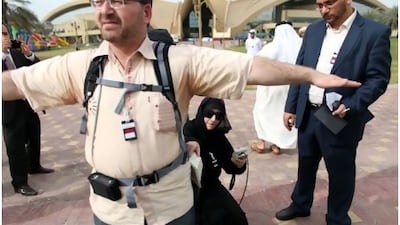ABU DHABI //As they paced carefully around a grassy park, carrying small devices that emitted rapidly accelerating beeping signals, the men could have easily been mistaken for metal-detecting hobbyists.
But instead of coins or other buried treasure, they were looking for radioactive material.
Canisters contaning the material were hidden as part of a training exercise yesterday at the Armed Forces Officers Club & Hotel to help officials better learn how to protect the public from harmful radiation.
The Federal Authority for Nuclear Regulation (FANR) and the US Department of Energy's National Nuclear Security Administration hid the containers on the property, both indoors and outdoors.
Officials were trained to use various detection devices to track down industrial radioactive materials.
Under regulated use, the materials in the canisters pose no hazard, officials said. However, if humans come into contact with the materials, they can cause burns and radiation poisoning, officials said.
Radioactive materials are used in many applications, such as the digging of oil wells or in body scanners. The materials are considered "orphan" sources when they are lost, stolen or fall outside of regulatory control.
"The UAE has as many radioactive sources, as do other countries in the world, especially considering the various industries here, including the oil industry and medical sector," said Dr John Loy, the director of radiation safety at FANR. "We are enhancing our strategy so that officials know how to search for them and recognise them."
The devices that officials used yesterday included a plastic scintillator, which illuminates when it detects radiation.
Another device, a small handheld sensor called the RadEye, is thousands of times more sensitive than a typical electronic radiation detector.
One radioactive material that the detectors found during yesterday's workshop was caesium-137, which has numerous industrial and medical uses.
About 30 Government officials participated in the exercise, including personnel from the National Crisis and Emergency Management Authority, the Critical National Infrastructure Authority, Civil Defence and the UAE Army's chemical unit.
While the workshop focused on finding orphan sources in industrial settings, the training could also be practical for security at borders and airports to guard against possible terrorist attacks, or at waste facilities where radioactive containers may have been buried and forgotten, Dr Loy said.
"We are looking for orphan sources that are already in the country and in field locations, factories, manufacturing sites and workplaces, but it is important to also have a strategy in place to monitor other possible places where such sources could appear," he said. "We don't want it to get into the wrong hands, or in the hands of someone who does not know how to handle it. If the seal is broken or the material becomes exposed, it could be very dangerous."
FANR is the UAE's independent nuclear regulator and conducts checks of companies and sites that it licenses.
Ahmed Sallam, a radiation safety inspector for FANR, said the technology that emergency officials used yesterday was slightly more advanced and sensitive than what he was used to, and made it easier for him to detect radiation from distances.
"This will benefit the work that I do, and gives me a new set of procedures when I am looking for a source," he said
Another Government official, Humaid al Yammahi, said he received training with a gamma spectrometer yesterday, which allowed him to detect different types of radiation at the same time.
The US Department of Energy's National Nuclear Security Administration has recovered nearly 25,000 radioactive materials around the world through its Off-Site Source Recovery Project, officials said.

